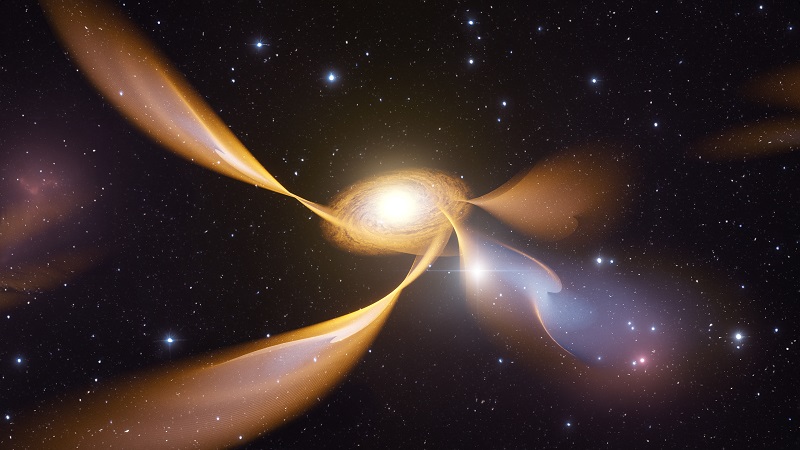Dutch astronomers prove last piece of gas feedback-feeding loop of black hole
Three astronomers from the Netherlands have proven that gas that was previously heated near a supermassive black hole and flowed to the outskirts of the galaxy and cooled down, is moving back towards the black hole. While there had been indirect evidence for this theory, this is the first time that the cooled gas moving toward the black hole has actually been observed. The researchers made their discovery when they used new techniques to examine archived data from the ALMA observatory. They share their findings in Nature Astronomy.

Supermassive black holes at the centers of galaxies have long been known to emit enormous amounts of energy. This causes the surrounding gas to heat up and flow far away from the center. This, in turn, makes the black hole less active and, let cool gas, in theory, flow back.
Three researchers from ASTRON, the Kapteyn Astronomical Institute/University of Groningen and JIVE, have now indeed shown that cool gas is flowing back. In this particular case it was cold carbon monoxide gas, but other cold gases are likely to flow back as well.
The astronomers used data collected by the ALMA observatory from the iconic galaxy 3C 84 (also referred to NGC 1275 or Perseus A). That galaxy is located 235 million light years away in the northern constellation of Perseus. It is the textbook example of what astronomers call "AGN feedback," or the recirculation of gas near a black hole. It had been known for decades that plasma jets from the supermassive black hole disrupt the hot gas around 3C 84 and that filaments of colder gas float in and around the system. And it had long been assumed that those filaments fall back toward the black hole, but it had never been proved.
"The data we used had previously been examined by another team of scientists," says lead researcher Tom Oosterloo (ASTRON and University of Groningen). "They couldn't remove the noise. We could. We used a new calibration technique that allowed us to image areas near the black hole three times sharper. And that is when we were able to detect the cool carbon monoxide gas flowing back.
In the future, the researchers plan to also map the flow of gas molecules other than carbon monoxide.
The research by Oosterloo and colleagues is unrelated to the study by Takuma Izumi and colleagues published in Science on November 3, 2023. Izumi investigated what happens to gas once it arrives in the gas disk near a black hole. Oosterloo and co-workers track gas moving from far away toward such a gas disk. Oosterloo and his team study what happens on a larger scale around a black hole and studying how that correlates with the evolution of the corresponding galaxy. Izumi's group focuses mainly on how a black hole is fed.
Scientific paper
Closing the feedback-feeding loop of the radio galaxy 3C 84. By: Tom Oosterloo, Raffaella Morganti & Suma Murthy. In: Nature Astronomy. [origineel | preprint (pdf)]
Source: NOVA / astronomie.nl
| Last modified: | 30 November 2023 4.57 p.m. |
More news
-
24 March 2025
UG 28th in World's Most International Universities 2025 rankings
The University of Groningen has been ranked 28th in the World's Most International Universities 2025 by Times Higher Education. With this, the UG leaves behind institutions such as MIT and Harvard. The 28th place marks an increase of five places: in...
-
05 March 2025
Women in Science
The UG celebrates International Women’s Day with a special photo series: Women in Science.
-
16 December 2024
Jouke de Vries: ‘The University will have to be flexible’
2024 was a festive year for the University of Groningen. In this podcast, Jouke de Vries, the chair of the Executive Board, looks back.
